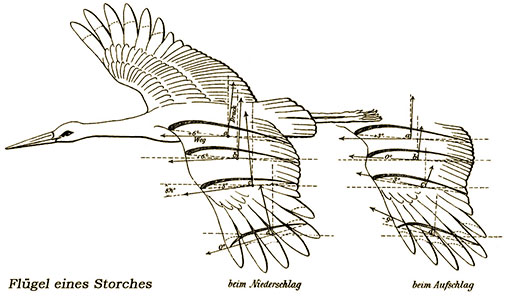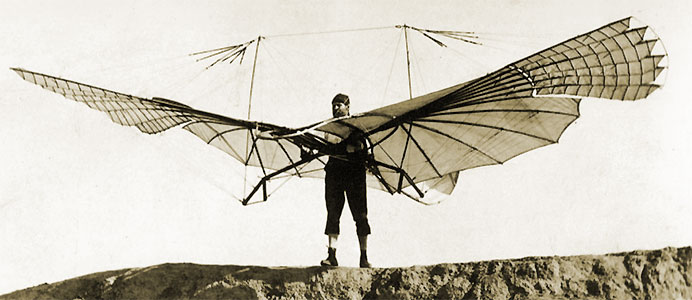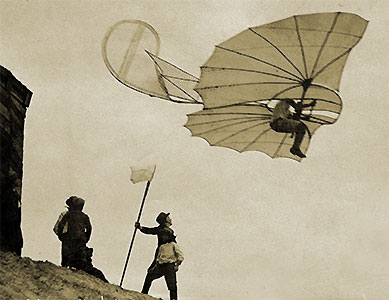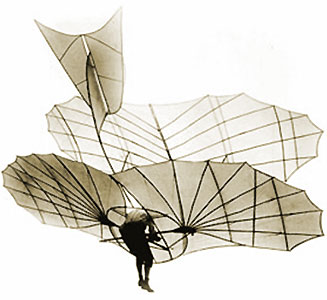 |
Human flight - Gliding |
|||
When he was a child, Otto Lilienthal observes, with his younger brother Gustav, the flight of birds, in particular the storks. At 14 years he made his first experiences with aircraft wings attached to his shoulders by straps. This passion will not affect his studies. From 1867, he began his flight experiments in earnest. Lilienthal understand that flight stability would be achieved with a cambered airfoil wing. It become evident to him, that a flying machine would be useless, if it could not be controlled. Going against the consensus of his time, he recommends an approach through experimental gliders because he does not believe in the future of the power flight |
And in 1873, Otto and Gustav become members of the Aeronautical Society of Great Britain. Lilienthal gave his first public lecture on the theory of bird flight. Afterward, he experimented methodical force of the air on artificial wings with models and kites and the characteristics of natural wind. His research on the shape of the wings enabled him to scientifically prove the capacity of the lift of the extrados of the wing which he published in his book: Der Vogelflug als der Grundlage Fliegekunst ("Birdflight as the basis of aviation") published in 1889 in Berlin. With this book Lilienthal finished his flight physical preliminary research studies of flight. Now he believed that he had the adequate knowledge to start building a man carrying apparatus. In 1891, Otto Lilienthal succeeded the first gliding flights in history with a distance of about 80 feet (Derwitz/Krilow near Potsdam) - This Derwitz glider is the “first successful manned aircraft” . During this series of flight experiments, Lilienthal reduced the glider's wingspan. |
 |
It is not quite satisfied with his success: "But still one thing is certain: we will not get anywhere just by talking and there is little research to do on the simple whirling arm device. We have to go on and we must try to be alone in the air on a real flight…. The transition to flight practise is therefore a necessary connection for building up our whole knowledge of aviation." "Even swimming has a distinctive theory…. Someone who has no knowledge of swimming and learned the theory well and has done land drills, will drown in all probability if he is in the situation to use his theoretical knowledge practically for the first time in order to save his life." The following year, Otto fly up to a distance of 90 yards (from a launching height of 30 feet) with a new glider which is on an aerodynamically sophisticated construction with fabric covering both sides of the wings. (Südende glider - 1892) |
 Small Wing-flapping 1893 (-1896) |
"What is the most ingenious man-made flying machine compared to those wings powered by nature's power? … The imitative wing of man is and always will be ... a poor instrument and still I can confirm by use of man-made flying devices that practise and experience will do their part in order to remove, step by step, certain imperfections and to improve considerably safety dealing with the wind." In 1893, At the top of the hill "Maihöhe" he built a 13-foot-tall shed and a launching ramp. It’is the beginning of his practice flights, or gliding, in the Rhinower Hills (Stölln/Rhinow near Neustadt/Dosse). Gliding up to a distance of about 800 feet. (Maihöhe-Rhinow glider, with 14 qm [150 sq. ft.] wing surface) "I gave up the large wing span of my early gliders step by step." "It seems to me to be inadvisable to extend the body in a stretched position …. Later one can possibly turn to that. » |
"I have already finished a steam engine that should move the wings during my next attempts. It has an overall weight of 20 kg producing 2 hp, and is being adjusted for an operating time of half an hour." At this time, he build several flying machines, among these a small wing flapping machine driven by a motor. Thus, in 1894 the first carbonic acid engine is ready for use. The results from the tests of the wing-flapping machine are not encouraging at first; nevertheless, Lilienthal continued with his attempts to imitate the wing flapping of birds. |
Serial production of the so-called "normal-glider" from 1894. The following year, Otto had a visit by flight technicians from different countries, among these S. P. Langley, secretary of the Smithsonian Institution in Washington and N. J. Shukowski, aerodynamics expert from Moscow. The Sturmflügelmodell (storm wing model) born in 1894. This glider was built with the same principles of construction as the normal glider. The wings are reduced in size in order to withstand stronger wind. |
 Sturmflügel-Modell (storm wing model) 1894 Sturmflügel-Modell (storm wing model) 1894 |
Then comes the period of biplanes in 1895. “The biplane design has the same lifting capacity of a single wing with twice the span, but the shorter span is more responsive to changes in the center of gravity." Lilienthal. The results were convincing. |
 Big Biplan 1895 |
"What cultural progress could be achieved if we could use the free atmosphere for air travel, where no mountains, no woods, no water, no marsh obstruct our movements. » 1896"Practical Experiments for the Development of Human Flight": «My experiments basically go in two directions. On one hand I am trying to extend my successes in gliding through the air with fixed wing devices as I learn to use stronger wind to achieve long-lasting flight. On the other hand I am trying to be successful in dynamic flight with the help of flapping wings, which are simply added to my gliders. I am not able to present final results because the necessary equipment still needs improvement.» Methodical and daring he performs over 2000 experiments between 1891 and 1896. His gliders are made of bamboo, rattan and cotton. He leaps from high places and against winds upward, gliders equipped with devices of various shapes where it hangs by the elbows and arms. Starting from 30 meters high, it covers a distance of 200 to 300 meters. Several times he manages to deviate from the straight line to the point of return for a certain time to its starting point. Sometimes he manages to rise above its starting altitude. Today, Otto Lilienthal is called the first aviator of mankind recognized. With his fundamental research on birds and wings, he founded the science of wing aerodynamics and lay the foundations for concepts we still employ today. |
His experiments and his scientific approach, his measurements on scale models of wings and his successful flights between 1891 and 1896 have enabled the Wright brothers to develop a controllable, self-propelled flying machine and to achieve in 1903 the first powered flight. |
| Source : Otto Lilienthal Museum - Ellbogenstraße 1, 17389 Anklam, Germany - Tel. : 03971 245500 - http://www.lilienthal-museum.de/olma/ehome.htm |
Human flight - Gliding |
|||